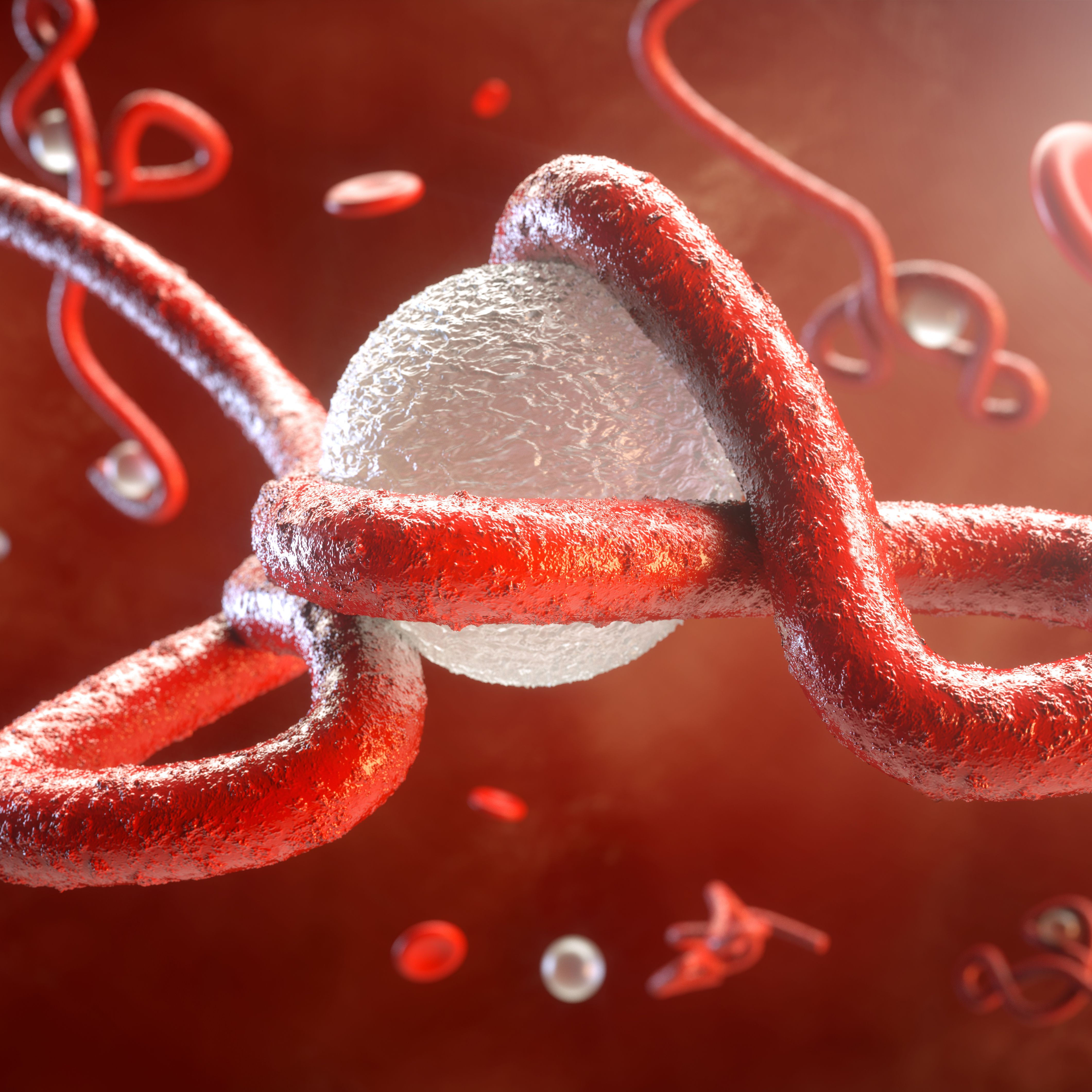
What is the Ebola virus?
The Ebola virus is one of the most dangerous viruses in the world. The Ebola virus causes a severe haemorrhagic fever and an increased tendency to bleed. It is one of the five viruses known so far from the filovirus family and belongs to the genus of Ebola viruses. The virus was responsible for the largest epidemic of Ebola fever to date in 2014 and 2015. Due to its high aggressiveness and great danger, the Ebola virus as a pathogen is even being discussed as a possible military warfare agent .
Where does the Ebola virus occur?
In 1976 the Ebola virus was discovered for the first time in Zaire, today's Democratic Republic of Congo. Since then, only outbreaks in Central Africa have been reported and registered.
How is the Ebola virus transmitted?
The Ebola virus can be transmitted in different ways.
Transmission from animal to human
The virus can be transmitted to humans through close contact with diseased animals or infectious animal products. It can be assumed that fruit bats in particular are the natural habitat of the pathogen, but this is not 100 per cent certain. Other animals such as monkeys or pigs that are infected with Ebola viruses also pose a risk of infection. Diseased animals should therefore be quarantined immediately. Dead animals must be removed and disposed of very carefully. It is best to avoid raw meat from these animals. Unlike some other infections from a tropical region, the Ebola virus is not transmitted by mosquito bites.
Transmission from person to person
An infection with the Ebola virus between two people in normal case only occurs through very close contact. Only in rare cases is the Ebola virus spread by coughing. An infected person is considered infectious as long as symptoms persist. Relatives or the nursing staff of Ebola-infected persons are particularly at risk of infection. Particularly careful handling is also advisable with persons who have died of Ebola and at the funeral. The same applies to people who have survived an infection with the Ebola virus. After 61 days after the symptoms and the disease have subsided, the Ebola virus could still be detected in the seminal fluid of male affected persons .
Risk of infection when travelling
According to experts, there is no increased risk for people travelling to Ebola areas. Only people who have close contact with an infected person are at risk. Nevertheless, holidaymakers should inform themselves about the current health situation in the holiday destination before setting off.
What are the symptoms of the Ebola virus?
The incubation period of the Ebola virus is between 2 and 21 days. The symptoms of Ebola include the following:
- Headache, aching limbs,
- high fever,
- Nausea, vomiting,
- Conjunctivitis,
- Skin rash,
- Kidney and liver dysfunction.
Already
a few days after the outbreak of Ebola, severe internal
and external bleeding can occur. The mucous membranes
are particularly affected. In addition to the eyes, the gastrointestinal tract and other
organs can also be involved.
In the further course of Ebola, various organs fail in many cases. In addition, encephalitis, i.e. inflammation of the brain, can occur, which further worsens the patient's chance of survival. Severe Ebola cases proceed as in septic shock and not rarely end in death due to heart failure.
How is the Ebola virus diagnosed?
In the early stages of the disease, it is difficult to tell the difference between Ebola fever and other diseases such as Lassa fever, yellow fever, dengue fever or even malaria. If there is a suspicion of an infection with the Ebola virus, the patient must be isolated at an early stage to prevent transmission to other people.
Since the Ebola virus can be detected most reliably in the blood, a blood sample is indispensable. Not all, but only laboratories with the highest safety levels are allowed to work with the Ebola virus or with the sample material from people with suspected Ebola virus.
How is the Ebola virus treated?
So far there is no specific treatment for Ebola, which is why so many people die from infection with the virus. Similarly, there are no standardised recommendations for treatment. Although treatment with an antiviral drug can be considered , it has hardly been successful so far.
Nevertheless, two quite new antibody preparations give hope. According to the current results, about 90 percent of patients can be cured with these drugs, provided it is administered early. So far, however, the drug has only been approved in the USA. There is no approval yet for the European countries.
In these countries, the Ebola virus can only be treated symptomatically . If possible, those affected receive intensive medical care in hospital . Sufficient supply of fluids with electrolytes is essential. If organ failure is imminent, organ replacement procedures must be started immediately.
How can the Ebola virus be prevented?
Two Ebola vaccines have already been approved in the European countries and in some other countries. The first approval was in 2019. This is a live vaccine that is administered to adults as an injection into the muscle, i.e. as with quite many other vaccinations. This vaccine has not been approved for children. Should a person fall ill with Ebola despite having received the vaccination, he or she usually experiences a less severe course of the disease.
Since July 2020, a combination vaccination has been approved in the European countries. This consists of two different vector vaccines and is injected in two doses. This vaccination against the Ebola virus is also approved for children.
Avoiding contact with the Ebola virus is still the safest preventive measure.
Is the Ebola virus notifiable?
In order to be able to avoid major outbreaks of the Ebola virus, a functioning early warning system is indispensable. This is why in Germany, Switzerland and in Austria itself, suspected cases must be reported to the public health authorities by mentioning the patient's name.
